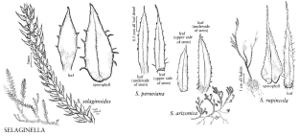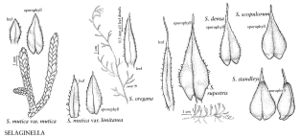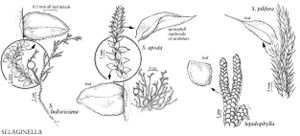Difference between revisions of "Selaginellaceae"
in Willkomm & Lange,
FNA>Volume Importer |
TammyCharron (talk | contribs) |
||
| (7 intermediate revisions by 2 users not shown) | |||
| Line 1: | Line 1: | ||
{{Treatment/ID | {{Treatment/ID | ||
|accepted_name=Selaginellaceae | |accepted_name=Selaginellaceae | ||
| − | |accepted_authority=Willkomm | + | |accepted_authority=Willkomm |
|publications={{Treatment/Publication | |publications={{Treatment/Publication | ||
|title=in Willkomm & Lange, | |title=in Willkomm & Lange, | ||
| Line 19: | Line 19: | ||
-->{{Treatment/Body | -->{{Treatment/Body | ||
|distribution=Worldwide;primarily in tropical and subtropical regions. | |distribution=Worldwide;primarily in tropical and subtropical regions. | ||
| − | |discussion=<p>Selaginellaceae traditionally include only one genus of living plants, Selaginella (A. C. Jermy 1990b; R. M. Tryon and A. F. Tryon 1982). Some authors (O. Kuntze 1891–1898, vol. 2, pp. 824–827; W. Rothmaler 1944), however, have segregated other genera based on generic concepts established by A. Palisot de Beauvois (1805, pp. 95–114), who recognized four genera. A. F. Spring (1850) combined the four genera into the broadly defined genus Selaginella. Spring's generic delimitation has resulted in misinterpretations that created many nomenclatural problems and partly led to the continued recognition of only one genus. Nevertheless, species in Selaginella fall into at least three well-defined groups, all present in North America, that may be recognized as genera based on anatomy, embryology, morphology and arrangement of the leaves and sporophylls, and morphology and symmetry of the strobilus. North American Selaginellaceae, which represent only a small portion of the family, are treated here in Selaginella, pending a full revision of the family worldwide.</p><!-- | + | |discussion=<p>Selaginellaceae traditionally include only one genus of living plants, <i>Selaginella</i> (A. C. Jermy 1990b; R. M. Tryon and A. F. Tryon 1982). Some authors (O. Kuntze 1891–1898, vol. 2, pp. 824–827; W. Rothmaler 1944), however, have segregated other genera based on generic concepts established by A. Palisot de Beauvois (1805, pp. 95–114), who recognized four genera. A. F. Spring (1850) combined the four genera into the broadly defined genus <i>Selaginella</i>. Spring's generic delimitation has resulted in misinterpretations that created many nomenclatural problems and partly led to the continued recognition of only one genus. Nevertheless, species in <i>Selaginella</i> fall into at least three well-defined groups, all present in North America, that may be recognized as genera based on anatomy, embryology, morphology and arrangement of the leaves and sporophylls, and morphology and symmetry of the strobilus. North American Selaginellaceae, which represent only a small portion of the family, are treated here in <i>Selaginella</i>, pending a full revision of the family worldwide.</p><!-- |
| − | --><p>Species in the fossil genus Selaginellites Zeller, which dates to the Carboniferous period, presumably are congeneric with Selaginella. Among the fern allies, Selaginellaceae are related only distantly to the other lycopod families, Lycopodiaceae and Isoëtaceae (R. M. Tryon and A. F. Tryon 1982).</p><!-- | + | --><p>Species in the fossil genus Selaginellites Zeller, which dates to the Carboniferous period, presumably are congeneric with <i>Selaginella</i>. Among the fern allies, Selaginellaceae are related only distantly to the other lycopod families, Lycopodiaceae and Isoëtaceae (R. M. Tryon and A. F. Tryon 1982).</p><!-- |
--><p>Genera 1, over 700 species (38 species in the flora).</p> | --><p>Genera 1, over 700 species (38 species in the flora).</p> | ||
|tables= | |tables= | ||
| Line 40: | Line 40: | ||
name=Selaginellaceae | name=Selaginellaceae | ||
|author=Iván A. Valdespino | |author=Iván A. Valdespino | ||
| − | |authority=Willkomm | + | |authority=Willkomm |
|rank=family | |rank=family | ||
|parent rank= | |parent rank= | ||
| Line 46: | Line 46: | ||
|basionyms= | |basionyms= | ||
|family=Selaginellaceae | |family=Selaginellaceae | ||
| − | |illustrator= | + | |illustrator=Laurie Klingensmith |
| + | |illustration copyright=Flora of North America Association | ||
|distribution=Worldwide;primarily in tropical and subtropical regions. | |distribution=Worldwide;primarily in tropical and subtropical regions. | ||
|reference=baker1887a;jermy1990a;tryon1982a | |reference=baker1887a;jermy1990a;tryon1982a | ||
| Line 52: | Line 53: | ||
|publication year= | |publication year= | ||
|special status= | |special status= | ||
| − | |source xml=https:// | + | |source xml=https://bitbucket.org/aafc-mbb/fna-data-curation/src/2e0870ddd59836b60bcf96646a41e87ea5a5943a/coarse_grained_fna_xml/V2/V2_123.xml |
}}<!-- | }}<!-- | ||
-->[[Category:Treatment]] | -->[[Category:Treatment]] | ||
Latest revision as of 15:43, 15 June 2022
Plants herbaceous, annual or perennial, sometimes remaining green over winter. Stems leafy, branching dichotomously, regularly or irregularly forked or branched, protostelic (sometimes with many protosteles or meristeles), siphonostelic, or actino-plectostelic. Rhizophores (modified leafless shoots producing roots) present or absent, geotropic, borne on stems at branch forks, throughout, or confined to base of stems. Leaves on 1 plant dimorphic or monomorphic, small, with adaxial ligule near base, single-veined [rarely veins forked]. Strobili (clusters of overlapping sporophylls) sometimes ill-defined, terminal [lateral], cylindric, quadrangular, or flattened. Sporophylls (fertile leaves) monomorphic or adjacently different, slightly or highly differentiated from vegetative (sterile) leaves. Sporangia short-stalked, solitary in axil of sporophylls, opening by distal slits. Spores of 2 types (plants heterosporous), megaspores (1–2–)4, large, microspores numerous (hundreds), minute.
Distribution
Worldwide, primarily in tropical and subtropical regions.
Discussion
Selaginellaceae traditionally include only one genus of living plants, Selaginella (A. C. Jermy 1990b; R. M. Tryon and A. F. Tryon 1982). Some authors (O. Kuntze 1891–1898, vol. 2, pp. 824–827; W. Rothmaler 1944), however, have segregated other genera based on generic concepts established by A. Palisot de Beauvois (1805, pp. 95–114), who recognized four genera. A. F. Spring (1850) combined the four genera into the broadly defined genus Selaginella. Spring's generic delimitation has resulted in misinterpretations that created many nomenclatural problems and partly led to the continued recognition of only one genus. Nevertheless, species in Selaginella fall into at least three well-defined groups, all present in North America, that may be recognized as genera based on anatomy, embryology, morphology and arrangement of the leaves and sporophylls, and morphology and symmetry of the strobilus. North American Selaginellaceae, which represent only a small portion of the family, are treated here in Selaginella, pending a full revision of the family worldwide.
Species in the fossil genus Selaginellites Zeller, which dates to the Carboniferous period, presumably are congeneric with Selaginella. Among the fern allies, Selaginellaceae are related only distantly to the other lycopod families, Lycopodiaceae and Isoëtaceae (R. M. Tryon and A. F. Tryon 1982).
Genera 1, over 700 species (38 species in the flora).


